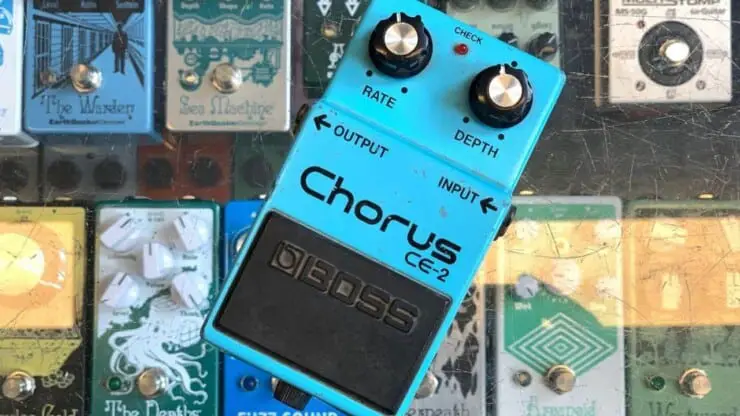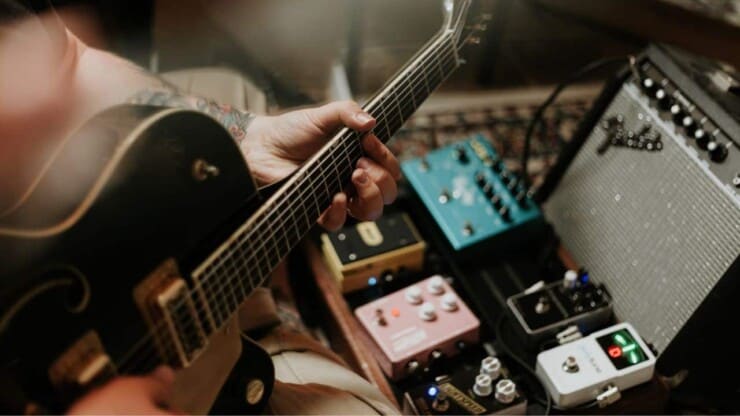Have you been listening to Mac DeMarco on repeat and want to emulate his signature chorus pedal sound? If so, then this article that the best thing you could have stumbled upon.
The chorus pedals that Mac DeMarco uses include Boss CE-2 Chorus, Ibanez SC-10 Super Stereo Chorus, and Roland JC-120 Jazz Chorus. The rest of the work is done by his amazing guitar rig and extraordinary skillset.
In this article, you will get to know all about chorus pedals, Mac DeMarco’s guitar rig, what chorus pedal does Mac DeMarco use, the secret to his amazing sound, and more. Continue reading to get all the answers about DeMarco and his guitar rig.
Mac DeMarco – The innovator of indie rock and Lo-Fi guitarists
For years, the unique chain-smoking Canadian musician has been charming festivals and theatres worldwide. He is popular for his distinctive gap-tooth smile, well-written songs, and bizarre sense of humor. Recording most of his music in his bedroom studio all by himself, he uses an array of vintage Japanese guitars, reel-to-reel recorders, synths, and chorus pedals. Through his guitar rig, he has managed to create a signature brand of stripped-back indie rock. Moreover, he has also inspired a whole wave of Lo-Fi imitators in his wake.
Although DeMarco’s music has evolved into a more sonically refined version of the laid-back, Lo-Fi brand of slacker rock that he first became known for, his ethos and knack for songwriting still remain a significant part of his solo output today. However, there is still no denying his influence over the last decade of guitarists and indie rock. If you’re a big fan of DeMarco, simply knowing what chorus pedal does Mac DeMarco use isn’t enough. You’ll also want to know about the gear he uses, his guitars, amps, synths, pedals, and more.
What chorus pedal does Mac DeMarco use?
DeMarco usually makes use of a small handful of effect pedals, including modulation effects and chorus pedals throughout his music. He rarely implements any filter effects or overdrive pedals. It was around 2014 that his pedalboard consisted of MXR Micro-Amp, Electro-Harmonix Holy Grail Reverb, Boss CE-2 Chorus, and a Boss TU-3 Tuner. However, he also uses many other guitar pedals to generate his signature sound.
Boss CE-2 Chorus

The Boss CE-1 Chorus Ensemble was the first Boss pedal, and its modulated effects are still being used by guitarists decades later. The Boss CE-2W Chorus Waza Craft Special Edition pedal manages to recreate the classic sound of the CE-1. The same happens with CE-2 Chorus, which makes use of the premium all-analog circuitry. You can switch between the standard CE-2 sound and CE-1 chorus and vibrato effect with the flip of a switch.
The CE-2W will exceed the capabilities of the original pedals. It’ll feature the stereo output of the CE-2 effects while featuring the variable depth for the CE-1 chorus pedals. The Boss CE-2 will also let you add expansive effects to the pedalboard and give a splendid chorus effect.
Ibanez SC-10 Super Stereo Chorus
The Power Series pedals that Ibanez released back in the 80s have been a highly sought-after group. A decent chunk of this group of pedals is available for extremely reasonable prices, too. The Ibanez SC-10 Super Stereo Chorus is a great little pedal full of charm and character.
The speed (or the rate of the effect) and the width (or the intensity of the chorus) are normally two of the most extreme chorus control knobs. They’re two of the three knobs present in the Ibanez SC-10. The third knob will be the Delay Time Control, which sets when the effect is brought into the mix. It features a range between 1ms and 7ms. This will be a great addition to bringing out the rich, subtle aspects of the SC10. Meanwhile, it works well with the other two knobs.
Utilizing this chorus pedal will help you experiment and play around with the chorus effect. It’ll produce intense and mellow tones, and fluttery chorus sounds, while also having a whole spectrum in between.
Not only that, but this pedal can also run in Stereo. This adds yet another feature to this already powerful unit’s mix. Another point worth mentioning is that the Ibanez SC10 runs on analog BBD circuitry, which makes it sound warm and vintage. It isn’t like most chorus pedals from that era that sounded harsh and biting. If you’re in the market for a cheap, amazing stereo chorus pedal that sounds amazing and has cool options, then the Ibanez SC10 Super Stereo Chorus will be an amazing option.
Roland JC-120 Jazz Chorus
Roland’s exciting JC-120 stereo combo amp is the flagship of the Jazz Chorus line. This chorus pedal has been setting the standard for crystal-clean guitar tones since 1975. This great 120W, 2×12-inch pedal will boast two separate power amps. It’s capable of delivering the signature true-stereo Dimension Space Chorus, making it one of the most revered effects ever.
The two channels will feature independent bright switches alongside 3-band EQs. There are also vibrato, distortion, reverb, and chorus available on the second channel to deliver different sounds. What’s more, this amp is bought tough and features a distinct riveted construction and rock-solid reliability. These two things have been the mainstay of the brand for decades.
The guitars in DeMarco’s guitar rig
1960s Teisco Electric Guitar
For years, Mac DeMarco’s primary guitar was a thrashed Japanese Teisco electric from the 60s. The teenage DeMarco acquired it for just $30 when he was living in Canada. In an interview, he mentioned that he went to a place called Lillo’s. It was a music store while also being a mini pawn shop. They brought him something crappy. As soon as he played the guitar, he was instantly surprised at how bad it was. They quoted the price as $30, and he immediately bought it.
Although it has now been retired by him from live use, the unique tone and quirky appearance of the single pickup Teisco has become a key part of his signature aesthetic. It has also been an important part of music in recent years. Moreover, it has inspired a revival of vintage Japanese guitars in indie music.
1970s Fender Stratocaster
Mac’s primary guitar between 2014 and 2016 was actually a vintage Fender Stratocaster with a Natural finish. It seems to have been made before Fender opted to go for a three-bolt neck and bullet truss rod design. Unfortunately, the guitar met with an untimely end when it got split in half after getting dropped onstage in Paris.
Although he did replace it with a 90s Japanese Squier, he acknowledged the heartbreak of breaking his vintage Fender. This guilt was deep, especially as he snapped a guitar priced at $4,000. Recently, he acquired a few more 70s-era Stratocasters for his live show, which also includes another natural-finished ’74 model.
Gibson J-45 Acoustic Guitar
For “This Old Dog”, his acoustic-heavy 2017 record, he used a ‘60s model Gibson J-45. It comes fitted with a Sunrise Soundhole Pickup as well.
Fender HSS Shawbucker Stratocaster
As a part of the endorsement deal with Fender, DeMarco’s live band got a total of 11 HSS Shawbucker Stratocasters. Moreover, there was also a lonely Telecaster.
Synths/Keyboards
Since he started using a Korg Microsampler and Yamaha DX7 on the woozy Salad Days cut “Chamber of Reflection”, he has developed a close affinity for synths. DeMarco also has a knack for collecting vintage Japanese models, which plays a key role in his music. He is proud of his collection, which also includes a Fender Rhodes Electric Piano and a Moog Realistic MG-1.
He has a Prophet 5, a Roland Juno 60, a Roland JX-3P, a Yamaha DX7, and a Yamaha DX100. Meanwhile, for his 2019 effort “Here Comes The Cowboy”, he gravitated towards using Casio synths from the 80s.
Amplifiers
Fender Vibro-Champ + Roland KC-550
Although DeMarco uses a Fender Vibro-Champ for studio recording, he also uses the small valve combo with a larger Roland KC-550 keyboard amp. This helps him power the band’s keyboard while acting as the stage monitor for himself. His combination involves bringing a big 200W keyboard amp and taking a small Fender amp before putting the small one on top of the big one. Then, he mics the small Fender amp with his own mic, which goes in the keyboard amp. He then runs all the keyboards on the stage into the big keyboard amp.
Fender Twin Reverb
Aside from using his signature Roland JC-120, he also tours with a 60W Fender Twin Combo amp.
Studio equipment
A big devotee of analog and vintage gear, Mac DeMarco has recorded most of his music on reel-to-reel tape recorders. It’s either a Fostex A-8 on 2 or Salad Days, or a Tascam 334 for Another One. He uses an Alesis Micro Limiter and a Roland Space Echo RE-201 for achieving his signature Lo-Fi sound.
However, his effort “This Old Dog” was recorded with his MacBook and an Apogee Quartet interface. He made use of Ableton with a setup that consisted of a Neumann U87 condenser mic, a Royer R-121 ribbon mic, and a 4-channel Neve Portico preamp strip. He also used a Roland CR-78 drum machine.
The secret to the sound of Mac DeMarco and how to emulate it
Throughout music history, there has long been a constant tug-of-war between solemnity and a sense of humor. Some of the best songs ever created balance magically between saving the world and making fun of it. Punk, grunge, progressive rock, and brit-pop all have examples of this throughout music history.
Mac DeMarco is undoubtedly succeeding in his balancing act. His music can be best described as a brilliant and iconic response to the messianism of history’s pop and rock icons. He embodies the opposite of over-the-top commercial pop – simplicity, lightness, slacker attitude, vintage integrity, and an almost vulgar sense of humor. Through his EPs and albums, this Canadian sensation has developed a sort of combination of Lo-Fi psychedelia and jangle pop.
What is the secret to his unique sound?
Since DeMarco himself never fully reveals this, it’ll be up to the viewer to listen and watch for the details. Apart from using vintage guitars, another big secret to his sound is the application of effects to the guitars. One of the permanent effect pedals will be the Boss CE-2, a combination of chorus and vibrato. It successfully recovers the sound of the mythical masterpieces Boss CE-1 and Boss CE-2. They’re key figures in the sound commonly associated with C-86 schools and jangle pop.
Two of the secrets of his guitars will be the tasteful use of delay and reverb. Regarding the latter, he makes use of the vintage-tinged Electro-Harmonix Holy Grail. Meanwhile, his preferred option for the delay effect is the 80s classic, Boss DM-2W Delay. It is commonly characterized by the analog aroma.
For finishing off his pedal showcase, it’ll be important to talk about another jewel of his crown – the Electro-Harmonix POG2. It is a generator of polyphonic octaves and makes the guitar sound like a weird church organ. It offers a cool yet weird sound.
His signature sound isn’t just made with guitars
Yes, you read that right. His trademark sound doesn’t just come with guitars, there’s more to that. It’s time to talk about another one of his great secrets regarding his signature sound – his use of synthesizers.
As mentioned before, a common feature of all the equipment used by Mac DeMarco is its marked vintage character. It’s a similar story to his synths. One of his favorite synths is the Prophet-5, which is a Californian synth manufacturer between 1978 and 1984 inclusive. Luckily, the synth market currently offers many alternatives to the Prophet-5. Undoubtedly, one of them is the Dave Smith Instruments Prophet REV2-8.
It is essentially an eight-voice polyphonic analog synth, while Prophet-5 had five voices. There are eight voices, which can be expanded to 16 via an external voice card. Among other features is the upgrade of the built-in software, which was a complaint of musicians who used prior versions. There is also a polyphonic step sequencer having around 64 steps (with 6 notes per step), 512 factory programs (with 4 banks of 128), and 512 user programs that stand out.
Another one of the synths that suit his style is the Roland Juno-DS 61. It is the heir to the mythical Juno-60. This is among the most intuitive synths out there. For that reason, and for an affordable price, it is often recommended for musicians to get into the world of synths. The Juno-DS 61 features a polyphony of 128 voices, 256 user memory patches, with 8 drum kits and 128 interpretations. There is also an intuitive 8-track pattern sequencer with nonstop recording. This will be ideal for recording song sketches securely and quickly.

Another model that you should consider is the Yamaha Reface DX. It is a compact 37-key synth with a format designed to be transported. You can easily operate it with batteries, with the keys at around 85% of the usual size. The dimensions will make it look similar to a desktop module rather than another synth. As far as the operations are concerned, it should be said that all complicated functionalities have been eliminated.
He also uses two extremely adaptable and portable Korg models. The first of them is the Korg microKORG. It’s an analog modeling synth, extremely versatile for its smaller size and based on the sound engine of Korg MS-2000. It features three octaves and offers four polyphonic voices. The built-in mic will allow working with a vocoder.
Additionally, it’ll come with an arpeggiator, a resonance filter, and a multitude of inputs and effects for managing external audios. The second one is very similar but has more varied features, and it is the Korg microKorg XL+. It features an eight-voice polyphony, 128 preset sounds, and a 16-band vocoder. The big difference with the microKorg is the sound engine. While it’ll have the MS-2000, meanwhile, the XL+ will work with an R3.
Conclusion
Thank you for reading. Hopefully, now you know more about chorus pedals, Mac DeMarco’s guitar rig, what chorus pedal does Mac DeMarco use, the secret to his amazing sound, and more. Mac DeMarco is known for his unique appearance, bizarre sense of humor, well-written songs, and innovative Lo-Fi music. He has recorded most of his music in his bedroom studio, utilizing an array of vintage Japanese guitars, synths, reel-to-reel recorders, and chorus pedals.
The chorus pedals that he normally uses are Boss CE-2 Chorus, Ibanez SC-10 Super Stereo Chorus, and Roland JC-120 Jazz Chorus. He also has an amazing skill set and immense creativity to add more flavor to his music.
Image Credit:
Images: Shopify



